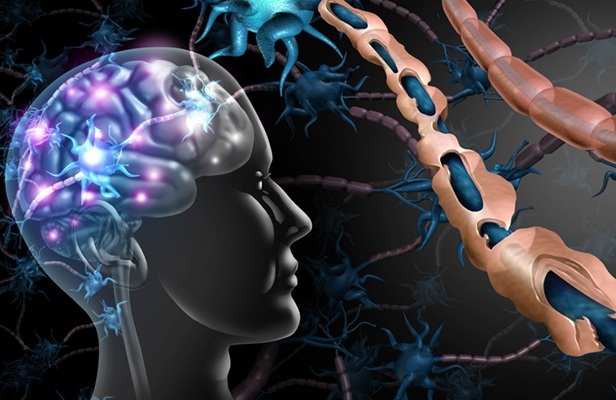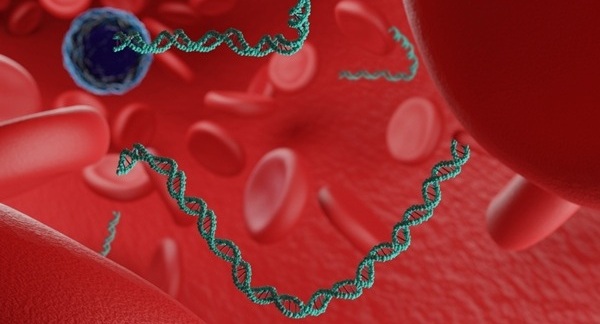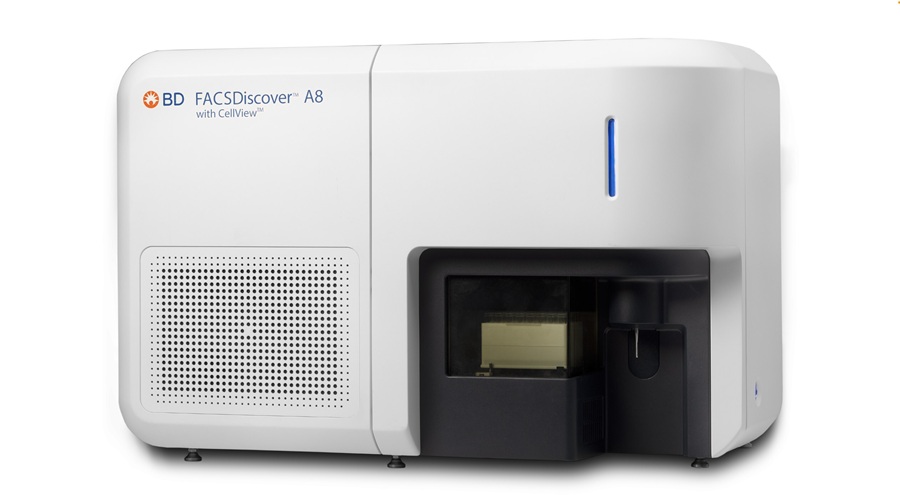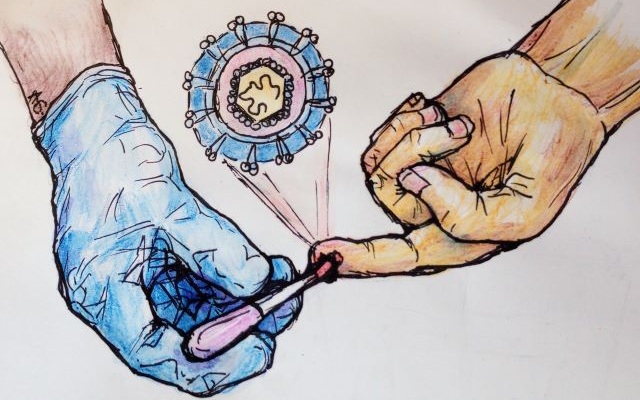Natural Method for Clearing Cellular Debris Inspires Lupus Treatment
|
By LabMedica International staff writers Posted on 06 Mar 2012 |
Cells that die naturally generate a large amount of internal debris that can trigger the immune system to attack the body, leading to diseases such as lupus. Now, researchers report that an enzyme known to help keep a woman’s immune system from attacking a fetus also helps block development of these autoimmune diseases that target healthy tissues.
The study’s findings lead to toward new treatment approaches for autoimmune diseases, which are increasing in light of a germ-conscious society that regularly destroys many of the previously pervasive microbes that made the immune system more tolerant. “The basic premise of lupus is you have lost normal tolerance to yourself, your own proteins, and DNA,” said Dr. Tracy L. McGaha, Georgia Health Sciences University (GHSU; Augusta, USA) immunologist and corresponding author of the study published ahead of print February 21, 2012, in the journal Proceedings of the [US] National Academy of Sciences.
The investigators discovered that IDO, or indoleomine 2,3-dioxegenase, helps promote tolerance to debris generated by natural cell death and that when IDO is removed from the mixture, the debris triggers an immune response that can induce autoimmune disease. In mice genetically engineered to develop lupus, blocking IDO resulted in earlier, more aggressive disease. “This connects IDO and macrophages. It’s a newly described role for IDO in regulation of tolerance toward self,” Dr. McGaha remarked. Accordingly, increasing IDO production or its downstream effects might be a way to regain lost tolerance, he said.
The researchers assessed activity in the spleen; a hard-working immune organ that constantly filters blood. In a flawlessly organized defense, the entrance to the spleen is surrounded by immune cells that search the blood for viruses, bacteria, even fat and cholesterol floating by.
A neighboring subset of macrophages, which are basically scavengers, then capture and consume the undesirables, according to Dr. McGaha said. Fascinatingly, a lot of what macrophages consume is dead immune cells.
Macrophages also appear to help keep the peace by preventing the immune system from joining the fray. Dr. McGaha earlier found that if he destroyed macrophages, then fed the spleen dead cells, there was inflammation instead of calm. “That tells us there is something inherent in this subset of macrophages that is important for the suppressive process,” Dr. McGaha said referencing the study published in 2011 in the journal Blood.
The new study revealed that IDO is part of that “something.” Efficient elimination of cell debris while keeping nearby immune cells quiet is important because some debris is known to grab the attention of the immune system, According to Dr. McGaha. He noted that it is normal--and healthy--for damaged cells to become targets. “We are really interested in this process of normal cell debris removal because in lupus, it's thought to be one of the main drivers of inflammation,” he said.
The immune system has points of expansion and regulation where it decides whether or not to act. Knowing key points, such as IDO’s regulatory role, provides treatment targets that can interrupt a destructive cascade of immune activity, Dr. McGaha noted. Earlier research has shown evidence of self-attack is present many years before disease symptoms appear, he said.
Environmental hazards, such as a nasty sunburn, can be the first trigger of the abnormal immune response in diseases such as lupus. In healthy individuals, the immune system rises to the occasion of an infection then goes back to baseline. In autoimmune disease, patients tend not to return to normal levels.
GHSU’s Drs. Andrew Mellor and David Munn reported in 1998 in the journal Science that the fetus expresses IDO to help avoid rejection by the mother’s immune system. Following studies have shown tumors also use it and that it could help transplanted organs escape rejection. They suggested that Dr. McGaha evaluate IDO as a regulatory process used by macrophages.
Related Links:
Georgia Health Sciences University
The study’s findings lead to toward new treatment approaches for autoimmune diseases, which are increasing in light of a germ-conscious society that regularly destroys many of the previously pervasive microbes that made the immune system more tolerant. “The basic premise of lupus is you have lost normal tolerance to yourself, your own proteins, and DNA,” said Dr. Tracy L. McGaha, Georgia Health Sciences University (GHSU; Augusta, USA) immunologist and corresponding author of the study published ahead of print February 21, 2012, in the journal Proceedings of the [US] National Academy of Sciences.
The investigators discovered that IDO, or indoleomine 2,3-dioxegenase, helps promote tolerance to debris generated by natural cell death and that when IDO is removed from the mixture, the debris triggers an immune response that can induce autoimmune disease. In mice genetically engineered to develop lupus, blocking IDO resulted in earlier, more aggressive disease. “This connects IDO and macrophages. It’s a newly described role for IDO in regulation of tolerance toward self,” Dr. McGaha remarked. Accordingly, increasing IDO production or its downstream effects might be a way to regain lost tolerance, he said.
The researchers assessed activity in the spleen; a hard-working immune organ that constantly filters blood. In a flawlessly organized defense, the entrance to the spleen is surrounded by immune cells that search the blood for viruses, bacteria, even fat and cholesterol floating by.
A neighboring subset of macrophages, which are basically scavengers, then capture and consume the undesirables, according to Dr. McGaha said. Fascinatingly, a lot of what macrophages consume is dead immune cells.
Macrophages also appear to help keep the peace by preventing the immune system from joining the fray. Dr. McGaha earlier found that if he destroyed macrophages, then fed the spleen dead cells, there was inflammation instead of calm. “That tells us there is something inherent in this subset of macrophages that is important for the suppressive process,” Dr. McGaha said referencing the study published in 2011 in the journal Blood.
The new study revealed that IDO is part of that “something.” Efficient elimination of cell debris while keeping nearby immune cells quiet is important because some debris is known to grab the attention of the immune system, According to Dr. McGaha. He noted that it is normal--and healthy--for damaged cells to become targets. “We are really interested in this process of normal cell debris removal because in lupus, it's thought to be one of the main drivers of inflammation,” he said.
The immune system has points of expansion and regulation where it decides whether or not to act. Knowing key points, such as IDO’s regulatory role, provides treatment targets that can interrupt a destructive cascade of immune activity, Dr. McGaha noted. Earlier research has shown evidence of self-attack is present many years before disease symptoms appear, he said.
Environmental hazards, such as a nasty sunburn, can be the first trigger of the abnormal immune response in diseases such as lupus. In healthy individuals, the immune system rises to the occasion of an infection then goes back to baseline. In autoimmune disease, patients tend not to return to normal levels.
GHSU’s Drs. Andrew Mellor and David Munn reported in 1998 in the journal Science that the fetus expresses IDO to help avoid rejection by the mother’s immune system. Following studies have shown tumors also use it and that it could help transplanted organs escape rejection. They suggested that Dr. McGaha evaluate IDO as a regulatory process used by macrophages.
Related Links:
Georgia Health Sciences University
Latest BioResearch News
- Genome Analysis Predicts Likelihood of Neurodisability in Oxygen-Deprived Newborns
- Gene Panel Predicts Disease Progession for Patients with B-cell Lymphoma
- New Method Simplifies Preparation of Tumor Genomic DNA Libraries
- New Tool Developed for Diagnosis of Chronic HBV Infection
- Panel of Genetic Loci Accurately Predicts Risk of Developing Gout
- Disrupted TGFB Signaling Linked to Increased Cancer-Related Bacteria
- Gene Fusion Protein Proposed as Prostate Cancer Biomarker
- NIV Test to Diagnose and Monitor Vascular Complications in Diabetes
- Semen Exosome MicroRNA Proves Biomarker for Prostate Cancer
- Genetic Loci Link Plasma Lipid Levels to CVD Risk
- Newly Identified Gene Network Aids in Early Diagnosis of Autism Spectrum Disorder
- Link Confirmed between Living in Poverty and Developing Diseases
- Genomic Study Identifies Kidney Disease Loci in Type I Diabetes Patients
- Liquid Biopsy More Effective for Analyzing Tumor Drug Resistance Mutations
- New Liquid Biopsy Assay Reveals Host-Pathogen Interactions
- Method Developed for Enriching Trophoblast Population in Samples
Channels
Clinical Chemistry
view channel
Blood Test Could Predict and Identify Early Relapses in Myeloma Patients
Multiple myeloma is an incurable cancer of the bone marrow, and while many patients now live for more than a decade after diagnosis, a significant proportion relapse much earlier with poor outcomes.... Read more
Compact Raman Imaging System Detects Subtle Tumor Signals
Accurate cancer diagnosis often depends on labor-intensive tissue staining and expert pathological review, which can delay results and limit access to rapid screening. These conventional methods also make... Read moreMolecular Diagnostics
view channel
Blood Test Combined with MRI Brain Scans Reveals Two Distinct Multiple Sclerosis Types
Multiple sclerosis (MS) affects more than 2.8 million people worldwide, yet predicting how the disease will progress in individual patients remains difficult. Current MS classifications are based on clinical... Read more
Ultra-Sensitive Blood Biomarkers Enable Population-Scale Insights into Alzheimer’s Pathology
Accurately estimating how many people carry Alzheimer’s disease pathology has long been a challenge, as traditional methods rely on small, clinic-based samples rather than the general population.... Read more
Blood Test Could Predict Death Risk in World’s Most Common Inherited Heart Disease
Hypertrophic cardiomyopathy (HCM) is the world’s most common inherited heart condition and affects millions of people globally. While some patients live with few or no symptoms, others develop heart failure,... Read moreHematology
view channel
MRD Tests Could Predict Survival in Leukemia Patients
Acute myeloid leukemia is an aggressive blood cancer that disrupts normal blood cell production and often relapses even after intensive treatment. Clinicians currently lack early, reliable markers to predict... Read more
Platelet Activity Blood Test in Middle Age Could Identify Early Alzheimer’s Risk
Early detection of Alzheimer’s disease remains one of the biggest unmet needs in neurology, particularly because the biological changes underlying the disorder begin decades before memory symptoms appear.... Read more
Microvesicles Measurement Could Detect Vascular Injury in Sickle Cell Disease Patients
Assessing disease severity in sickle cell disease (SCD) remains challenging, especially when trying to predict hemolysis, vascular injury, and risk of complications such as vaso-occlusive crises.... Read more
ADLM’s New Coagulation Testing Guidance to Improve Care for Patients on Blood Thinners
Direct oral anticoagulants (DOACs) are one of the most common types of blood thinners. Patients take them to prevent a host of complications that could arise from blood clotting, including stroke, deep... Read moreImmunology
view channel
Ultrasensitive Liquid Biopsy Demonstrates Efficacy in Predicting Immunotherapy Response
Immunotherapy has transformed cancer treatment, but only a small proportion of patients experience lasting benefit, with response rates often remaining between 10% and 20%. Clinicians currently lack reliable... Read more
Blood Test Could Identify Colon Cancer Patients to Benefit from NSAIDs
Colon cancer remains a major cause of cancer-related illness, with many patients facing relapse even after surgery and chemotherapy. Up to 40% of people with stage III disease experience recurrence, highlighting... Read moreMicrobiology
view channel
New UTI Diagnosis Method Delivers Antibiotic Resistance Results 24 Hours Earlier
Urinary tract infections affect around 152 million people every year, making them one of the most common bacterial infections worldwide. In routine medical practice, diagnosis often relies on rapid urine... Read more
Breakthroughs in Microbial Analysis to Enhance Disease Prediction
Microorganisms shape human health, ecosystems, and the planet’s climate, yet identifying them and understanding how they are related remains a major scientific challenge. Even with modern DNA sequencing,... Read morePathology
view channel
Genetics and AI Improve Diagnosis of Aortic Stenosis
Aortic stenosis is a progressive narrowing of the aortic valve that restricts blood flow from the heart and can be fatal if left untreated. There are currently no medical therapies that can prevent or... Read more
AI Tool Simultaneously Identifies Genetic Mutations and Disease Type
Interpreting genetic test results remains a major challenge in modern medicine, particularly for rare and complex diseases. While existing tools can indicate whether a genetic mutation is harmful, they... Read more
Rapid Low-Cost Tests Can Prevent Child Deaths from Contaminated Medicinal Syrups
Medicinal syrups contaminated with toxic chemicals have caused the deaths of hundreds of children worldwide, exposing a critical gap in how these products are tested before reaching patients.... Read more
Tumor Signals in Saliva and Blood Enable Non-Invasive Monitoring of Head and Neck Cancer
Head and neck cancers are among the most aggressive malignancies worldwide, with nearly 900,000 new cases diagnosed each year. Monitoring these cancers for recurrence or relapse typically relies on tissue... Read moreTechnology
view channel
Pioneering Blood Test Detects Lung Cancer Using Infrared Imaging
Detecting cancer early and tracking how it responds to treatment remains a major challenge, particularly when cancer cells are present in extremely low numbers in the bloodstream. Circulating tumor cells... Read more
AI Predicts Colorectal Cancer Survival Using Clinical and Molecular Features
Colorectal cancer is one of the most common and deadly cancers worldwide, and accurately predicting patient survival remains a major clinical challenge. Traditional prognostic tools often rely on either... Read moreIndustry
view channel
BD and Penn Institute Collaborate to Advance Immunotherapy through Flow Cytometry
BD (Becton, Dickinson and Company, Franklin Lakes, NJ, USA) has entered into a strategic collaboration with the Institute for Immunology and Immune Health (I3H, Philadelphia, PA, USA) at the University... Read more










 (3) (1).png)









